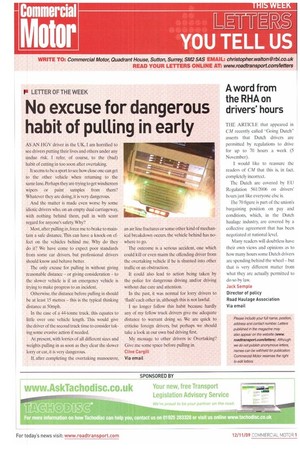P LETTER OF THE WEEK
Page 19

If you've noticed an error in this article please click here to report it so we can fix it.
No excuse for dangerous habit of pulling in early
AS AN HGV driver in the UK, I am horrified to see drivers putting their lives and others under any undue risk. I refer, of course, to the (bad) habit of cutting in too soon after overtaking.
It seems to be a sport to see how close one can get to the other vehicle when returning to the Same lane. Perhaps they are trying to get windscreen wipers or paint samples from them? Whatever they are doing.. it is very dangerous.
And the matter is made even worse by some idiotic drivers who, on an empty dual carriageway, with nothing behind them, pull in with scant regard for anyone's safety. Why?
Most, after pulling in, force me to brake to maintain a safe distance. This can have a knock-on effect on the vehicles behind me. Why do they do it? We have come to expect poor standards from some car drivers, but professional drivers should know and behave better.
The only excuse for pulling in without giving reasonable distance — or giving consideration — to the slower vehicle is if an emergency vehicle is in,,ing to make progress loan incident.
Otherwise, the distance before pulling in should he at least 15 metres — this is the typical thinking distance at 50mph.
In the case of a 44-tonne truck, this equates to little over one vehicle length. This would give the driver of the second truck time to consider taking some evasive action if needed.
At present, with lorries of all different sizes and weights pulling in as soon as they clear the slower lorry or car, it is very dangerous.
if, after completing the overtaking manoeuvre,
an air line fractures or some other kind of mechanical breakdown occurs, the vehicle behind has nowhere to go.
The outcome is a serious accident, one which could kill or even maim the offending driver from the overtaking vehicle if he is shunted into other traffic or an obstruction.
It could also lead to action being taken by the police for dangerous driving and/or driving without due care and attention.
In the past, it was normal for lorry drivers to 'flash' each other in, although this is not lawful.
I no longer follow this habit because hardly any of my fellow truck drivers give me adequate distance to warrant doing so. We are quick to criticise foreign drivers, but perhaps we should take a look at our own bad driving first.
My message to other drivers is: Overtaking? Give me some space before pulling in.
Clive Cargill
Via email
















































































































































